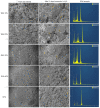Development and Analysis of a Hydroxyapatite Supplemented Calcium Silicate Cement for Endodontic Treatment
- PMID: 35161119
- PMCID: PMC8839244
- DOI: 10.3390/ma15031176
Development and Analysis of a Hydroxyapatite Supplemented Calcium Silicate Cement for Endodontic Treatment
Abstract
Aim: To develop an endodontic cement using bovine bone-derived hydroxyapatite (BHA), Portland cement (PC), and a radiopacifier. Methods: BHA was manufactured from waste bovine bone and milled to form a powder. The cements were developed by the addition of BHA (10%/20%/30%/40% wt), 35% wt, zirconium oxide (radiopacifier) to Portland cement (PC). A 10% nanohydroxyapatite (NHA) cement containing PC and a radiopacifier, and a cement containing PC (PC65) and a radiopacifier were also manufactured as controls. The cements were characterised to evaluate their compressive strength, setting time, radiopacity, solubility, and pH. The biocompatibility was assessed using Saos-2 cells where ProRoot MTA acted as the control. Compressive strength, solubility and pH were evaluated over a 4-week curing period. Results: The compressive strength (CS) of all cements increased with the extended curing times, with a significant CS increase in all groups from day 1 to day 28. The BHA 10% exhibited significantly higher CS compared with the other cements at all time points investigated. The BHA 10% and 20% groups exhibited significantly longer setting times than BHA 30%, 40% and PC65. The addition of ZrO2 in concentrations above 20% wt and Ta2O5 at 30% wt resulted in a radiopacity equal to, or exceeding that of, ProRoot MTA. The experimental cements exhibited relatively low cytotoxicity, solubility and an alkaline pH. Conclusions: The addition of 10% and 20% BHA to an experimental PC-based cement containing 35% ZrO2 improved the material's mechanical strength while enabling similar radiopacity and biocompatibility to ProRoot MTA. Although BHA is a cost-effective, biomimetic additive that can improve the properties of calcium silicate endodontic cements, further studies are now warranted to determine its clinical potential.
Keywords: biocompatibility; bovine derived hydroxyapatite; calcium silicate cement; compressive strength; radiopacity.
Conflict of interest statement
The authors declare no conflict of interest.
Figures







Similar articles
-
Effect of addition of nano-hydroxyapatite on physico-chemical and antibiofilm properties of calcium silicate cements.J Appl Oral Sci. 2016 May-Jun;24(3):204-10. doi: 10.1590/1678-775720150422. J Appl Oral Sci. 2016. PMID: 27383700 Free PMC article.
-
Evaluation of the physical properties of an endodontic Portland cement incorporating alternative radiopacifiers used as root-end filling material.Int Endod J. 2010 Mar;43(3):231-40. doi: 10.1111/j.1365-2591.2009.01670.x. Int Endod J. 2010. PMID: 20158535
-
Investigation of the hydration and bioactivity of radiopacified tricalcium silicate cement, Biodentine and MTA Angelus.Dent Mater. 2013 May;29(5):580-93. doi: 10.1016/j.dental.2013.03.007. Epub 2013 Mar 26. Dent Mater. 2013. PMID: 23537569
-
Development of novel tricalcium silicate-based endodontic cements with sintered radiopacifier phase.Clin Oral Investig. 2016 Jun;20(5):967-82. doi: 10.1007/s00784-015-1578-1. Epub 2015 Sep 1. Clin Oral Investig. 2016. PMID: 26323502
-
The effect of curing conditions on the physical properties of tricalcium silicate cement for use as a dental biomaterial.Int Endod J. 2012 Apr;45(4):326-36. doi: 10.1111/j.1365-2591.2011.01980.x. Epub 2011 Nov 2. Int Endod J. 2012. PMID: 22044176
Cited by
-
Bioactivity Potential of Bioceramic-Based Root Canal Sealers: A Scoping Review.Life (Basel). 2022 Nov 11;12(11):1853. doi: 10.3390/life12111853. Life (Basel). 2022. PMID: 36430988 Free PMC article.
-
Bioceramic versus traditional biomaterials for endodontic sealers according to the ideal properties.Histol Histopathol. 2024 Mar;39(3):279-292. doi: 10.14670/HH-18-664. Epub 2023 Sep 8. Histol Histopathol. 2024. PMID: 37747049 Review.
-
The comparison of physicochemical and bioactivity properties of different nanoparticles modified calcium silicate-based cement.BMC Oral Health. 2025 Aug 18;25(1):1335. doi: 10.1186/s12903-025-06660-5. BMC Oral Health. 2025. PMID: 40826453 Free PMC article.
-
Potential Beneficial Effects of Hydroxyapatite Nanoparticles on Caries Lesions In Vitro-A Review of the Literature.Dent J (Basel). 2023 Feb 7;11(2):40. doi: 10.3390/dj11020040. Dent J (Basel). 2023. PMID: 36826185 Free PMC article. Review.
-
Bioceramics in Endodontics: Limitations and Future Innovations-A Review.Dent J (Basel). 2025 Apr 1;13(4):157. doi: 10.3390/dj13040157. Dent J (Basel). 2025. PMID: 40277487 Free PMC article. Review.
References
-
- Iandolo A., Ametrano G., Amato M., Rengo S., Simeone M. IG-File: A novel tool to improve root canal cleaning and measurement of the apical foramen. Giornale Italiano Di Endodonzia. 2011;25:72–81. doi: 10.1016/j.gien.2011.07.001. - DOI
-
- Iandolo A., Dagna A., Poggio C., Capar I., Amato A., Abdellatif D. Evaluation of the actual chlorine concentration and the required time for pulp dissolution using different sodium hypochlorite irrigating solutions. J. Conserv. Dent. JCD. 2019;22:108. doi: 10.4103/JCD.JCD_165_19. - DOI - PMC - PubMed
Grants and funding
LinkOut - more resources
Full Text Sources

